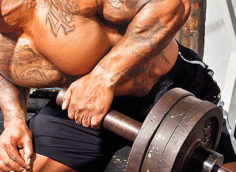The Problem With Back Training
A seasoned lifter knows how to manage the ratio of training volume and intensity against accumulated fatigue. Accumulate too much central nervous system, cardiovascular, or mechanical fatigue during or across workouts and your results won't be optimal.
But when we're talking about fatigue, lifters often forget about the localized kind. What happens when fatigue sets in for the supporting body parts during major movements?
During certain exercises, our legs and lower backs will often fatigue before our lats and other upper-back muscles. This is especially true if our program includes deadlifts or barbell rows.
Traditional bodybuilding back workouts often begin with deadlifts and pull-ups before moving on to bent-over barbell or T-bar rows. Bent-over rows are limited not by the work capacity of your lats, but the structural stamina of your legs, hips, and lower back.
While those support muscles aren't moving, they're holding isometric contractions through your sets and accumulating fatigue. As a result, you can't always take your back muscles to near failure or use the intensity required to maximize their growth.
It may also result in sloppy form, which takes tension away from the intended target muscles. This isn't an argument against bent-over rows though. It's a discussion of how to best complement exercises for the best result. So let's solve the problem.
Complement your big, full-body fatiguing back exercises with localized upper-back movements. Add some exercises that target the upper back without putting too much tension on those other commonly fatigued areas.
Using inverted rows is one of the best ways to add targeted upper-back training volume. Quick and easy setup combined with easily adjusted difficulty makes for an efficient alternative to the traditional free weight and machine back training repertoire.
Rings, straps, and Swiss bars allow for a neutral grip, while barbells and Smith machines require overhand or underhand positions. Go with what's available and what you like best.
Inverted Ring Row
Feet-Elevated Ring Row
Begin with 8 to 12 strict reps and go "heavy" enough to take the set to near failure.
The more horizontal your body, the harder it'll be. So you may need to begin with your feet on the ground and your body at 45-degrees, or you may be strong enough to elevate your feet on a bench with your body parallel to the ground. As you get stronger, progress by changing the angle.
When simply elevating your feet becomes too easy, add load with sandbags or a weighted vest. If you struggle to finish a set at the angle you've chosen, just adjust your foot position (mid-set) to an easier angle to finish the set.
Flex your abs to prevent excessively arching your lower back, which cheats you into a shorter range of motion. Squeeze and engage your glutes to keep your hips from sagging, and avoid using momentum or "kipping" the rep.
Use a complete range of motion from fully extended arms and protracted scapula at the bottom of the row, to fully retracted scapula and humerus parallel to the body at the top of the row.
Don't just complement your big lifts with inverted rows, use chest-supported and machine rows to limit any leg, hip, and lumbar fatigue while maximizing upper-back mechanical tension, metabolic stress, and muscle damage.
Use this approach for at least three months before making any more major changes.
This back program begins with heavier, multi-joint compound lifts and progresses into more focused upper-back exercises.
- Deadlift: 2 warm-up sets of 8-10 reps, then 3 working sets of 5-8 reps
- Pull-up or Chin-up: 4 sets of strict reps to near failure. If you can easily do more than 12 per set, add weight. Focus on improving your total number of reps across four sets each week. Or choose a predetermined number to hit, then do as many sets as needed to reach that total.
- Chest-Supported Row: 4 sets of 10-12 reps to near failure. Use a chest-supported T-bar machine, dumbbells and an incline bench, or even a SEAL row barbell setup.
- Inverted Row: 4 sets of 8-12. Drop-set the last set twice by regressing to an easier angle.
- Seated Cable or Machine Row: 4 sets of 15
- Dumbbell or Cable Pullover: 3 sets of 10-12
The most important factor in long-term strength and physique progress is staying in the game week after week and not being sidelined with injuries.
Complement your whole-body exercises with more isolated movements which don't needlessly add fatigue and stress to body parts that are already straining to recover. Inverted row variations are among the best upper-back training options without adding to leg, hip, and lower back stress.





